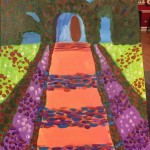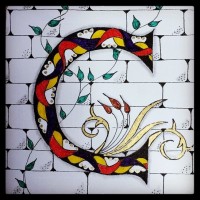I admit it. I overthink to a fault such that progress sometimes grinds to an unceremonious halt. Building a website is a challenge, but if all you have is a blog, it doesn’t have to be. Sure, I want to add a portfolio, an Etsy store, a form, some other tidbits. But right now? It’s just a blog. So, thanks to the advice of a friend, the infamous Rob Patey, I reworked my theme to this simple one (a Genesis Child Theme called Blissful Child Theme), made a couple of adjustments and added a social plug-in, and POOF. Unstuck. I’ve desperately wanted to document my journey leading up to my Certified Zentangle Teacher training in April and I lost an entire month. Water under the bridge.
During the month of February, I focused on a couple of things. First, I did the now official 2nd annual tangle practice sketchbook. Meaning? I took every single tangle I have documented in Evernote (that’s how I organize tangles, strings, and inspiring patterns in the world – more on that another day) and drew it at least once in a sketchbook from A-Z. Since finishing that, I’ve been adding new ones as they are posted on Tangle Patterns or if I picked up new ones on Flickr, Instagram, or Pinterest. I’m not quite up to date but I’m close.
 I also invested in learning a lot more about henna, including reading this amazing book called Henna House, by Nomi Eve, which helped me connect the practice of henna to my Jewish heritage. Now, I won’t lie, one of my main interests in learning about henna and Yemenite Jews was to legitimize my interest for my 80-year-old Jewish mother (read in your best 80-year-old-Jewish mother voice: “Tattoos are evil and wrong! And you can’t be buried in a Jewish cemetery if you have one!” and I do…).
I also invested in learning a lot more about henna, including reading this amazing book called Henna House, by Nomi Eve, which helped me connect the practice of henna to my Jewish heritage. Now, I won’t lie, one of my main interests in learning about henna and Yemenite Jews was to legitimize my interest for my 80-year-old Jewish mother (read in your best 80-year-old-Jewish mother voice: “Tattoos are evil and wrong! And you can’t be buried in a Jewish cemetery if you have one!” and I do…).
Here’s the author’s own summary (because at 6 PM on a Wednesday, my creative writing juices are running thin):
An evocative and stirring novel about a young woman living in the fascinating and rarely portrayed community of Yemenite Jews of the mid-twentieth century…In the tradition of Anita Diamant’s The Red Tent, Henna House is the enthralling story of a woman, her family, their community, and the rituals that bind them.
Whether you are Jewish or not, interested in henna or not, you will not be disappointed in this book. One caveat, you should probably run higher on estrogen than testosterone to enjoy it.
I also scheduled an instructive session with a more experienced henna artist so I can dig into the best recipes and techniques for mixing henna, making cones that will give me more control, and taking more control with the tip of the cone. I feel like once I have a better grip on these things, I’ll be able to translate drawings to henna designs and apply them with confidence.
 I’ve done some drawing too, and discovered this wonderful thing I can’t believe I never heard of before called Illuminated Letters. These are the fancy letters you see starting a chapter in a really old book. A square, usually, with a fancy letter inside decorated to complement the text. Then the artist essentially gilds it with gold (real gold, back in the day; now gold ink) and it looks positively regal. This was my first shot at it, and I’m a little bit afraid if I invest more time in it, I could be addicted. But it’s a fun way to express some tangles and add a little color to the palette.
I’ve done some drawing too, and discovered this wonderful thing I can’t believe I never heard of before called Illuminated Letters. These are the fancy letters you see starting a chapter in a really old book. A square, usually, with a fancy letter inside decorated to complement the text. Then the artist essentially gilds it with gold (real gold, back in the day; now gold ink) and it looks positively regal. This was my first shot at it, and I’m a little bit afraid if I invest more time in it, I could be addicted. But it’s a fun way to express some tangles and add a little color to the palette.
 And actually, I painted! I know! I don’t paint, or at least I didn’t, but I went to a ladies’ evening at The Uncorked Artist and painted this Monet-wanna-be canvas. It’s just shy of art…but I had fun doing it and experimenting with a new medium. Yeah, I’d do it again. I kinda remember now why I loved smock day in my elementary school art class!
And actually, I painted! I know! I don’t paint, or at least I didn’t, but I went to a ladies’ evening at The Uncorked Artist and painted this Monet-wanna-be canvas. It’s just shy of art…but I had fun doing it and experimenting with a new medium. Yeah, I’d do it again. I kinda remember now why I loved smock day in my elementary school art class!
I encourage and appreciate sharing!:

Comments are closed.